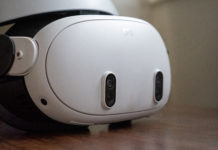Last Update on November 25, 2024
In the digital age, two fascinating technologies are capturing attention: augmented reality (AR) and virtual reality (VR). Although they may seem similar, they offer distinct experiences: AR enhances our world with virtual elements, while VR immerses us in an entirely artificial universe. These innovations promise to revolutionize numerous sectors, from education to online commerce, offering possibilities that were previously unimaginable. This article aims to demystify AR and VR, exploring their differences, applications, and envisioning their promising future.
What is Virtual Reality?
Virtual reality (VR) is like an open window to parallel universes, where the limits of what is possible are redefined by the power of technology. Imagine putting on a VR headset and instantly being transported to Mars, in the middle of a historical battle, or even inside a human cell. This is the promise of virtual reality: total immersion in an artificial world, where every detail, sound, and interaction is computer-generated to simulate an experience as rich as reality itself.
Beyond the wonder, VR is applied in concrete ways and transforms many sectors. In real estate, it allows prospective homeowners to tour houses and apartments that do not yet physically exist, offering a 360-degree view of developing projects. The education sector also benefits from this technology, providing educational journeys through time and space, making learning more interactive and memorable.
In healthcare, VR is revolutionizing medical training and the treatment of certain conditions, allowing surgeons to practice on hyper-realistic simulations or patients to overcome their phobias in a controlled environment. The possibilities seem endless, from architectural design to sports training, where each field can benefit from unprecedented immersion and interaction.
What is Augmented Reality?
Augmented reality (AR) is a technology that enhances our perception of the real world by overlaying virtual elements, creating a symbiosis between the real and the digital. Unlike virtual reality, which isolates us in a completely artificial universe, AR adds a layer of information or imagination to our direct environment, opening new dimensions to our daily lives.
This technology manifests in various ways, ranging from mobile apps that project 3D objects into our living rooms, to sophisticated glasses that allow viewing interactive data overlaid on our field of vision. Imagine pointing your smartphone at a restaurant and seeing customer reviews or the daily menu appear overlaid on the screen, or surgeons viewing vital patient information in real-time during an operation, without ever taking their eyes off their field of work.
The applications of AR are vast and span several sectors. In retail, it allows consumers to virtually try on clothes or see how furniture would fit into their homes. In education, it transforms textbooks into interactive experiences, where elements animate and interact with the learner. In industry, it assists technicians by overlaying repair guides or schematics directly on the equipment they are fixing.
Comparison Between Augmented Reality and Virtual Reality

At the heart of technological innovation, augmented reality (AR) and virtual reality (VR) present themselves as two facets of the same quest: to enhance our experience of the world through the lens of digital technology. While they share common roots in their capacity to transform our perception of reality, AR and VR differ significantly in their approach and impact on how we interact with our environment.
Immersion vs. Overlay
- VR envelops us in a digital cocoon, a parallel world where everything—from the horizon to the nearest object—is a creation of human imagination, translated into pixels. It is an escape, a journey into the unknown that cuts us off from the real world to immerse us in fantastical universes or hyper-realistic simulations.
- In contrast, AR acts as an additional layer to our reality, an enriching filter that overlays information, objects, or animations onto our immediate environment. It doesn’t pull us away from our world but rather makes it richer and more interactive.
Gateways to Immersion
- To access these virtual worlds, VR requires specific gateways: immersive headsets, rooms equipped with sensors, isolating us from the outside world to better immerse us in its alternative universe.
- AR, more discreetly, enters our daily lives through familiar screens: smartphones, tablets, or smart glasses, transforming our immediate perception without disconnecting us from our environment.
Applications in Daily Life
- VR proves to be a powerful tool for exploration, learning, and escapism. It allows us to visit Egyptian pyramids, dive into the ocean to encounter marine creatures, or train for complex tasks in a risk-free environment.
- AR, on the other hand, finds its place in our interaction with the world around us. It guides us through the streets of an unfamiliar city with floating directional arrows, helps us visualize how a new sofa would fit into our living room, or transforms a simple book into an interactive adventure populated with animated characters.
In summary, while VR offers us a ticket to alternate worlds where imagination defies the laws of physics, AR subtly infuses magic into our daily lives, making the ordinary extraordinary. Whereas VR asks us to dive headfirst into the unknown, AR takes us by the hand, enriching our reality step by step. Together, they sketch a future where the real and the virtual dance in harmony, promising ever more enriching and immersive experiences.
The Best Virtual and Augmented Reality Headsets
On the fascinating journey through digital dimensions, augmented reality (AR) and virtual reality (VR) headsets prove to be our most valuable companions. These devices, true passports to the unknown, invite us to explore territories where the real blends with the imaginary, redefining our sensory and cognitive experiences. Here’s an overview of the key artifacts that mark this exploration path.
Virtual Reality Headsets
- Oculus Quest 2: A true gem of VR technology, the Oculus Quest 2 stands out for its ease of use and autonomy, propelling its users into incredibly rich virtual worlds without the need for cables or an external computer.
- HTC Vive Cosmos: Designed for virtual explorers seeking detail and precision, the HTC Vive Cosmos is an open window to breathtakingly clear universes, where every movement is captured with remarkable fidelity.
- Valve Index: For VR pioneers seeking the ultimate experience, the Valve Index represents the pinnacle, with its revolutionary controllers that track finger movements, immersing the user in unprecedented interaction with the digital world.
Augmented Reality Headsets
- Microsoft HoloLens 2: The HoloLens 2 embodies the cutting edge of AR, offering a platform where the physical world and holograms coexist, opening new perspectives for collaboration, training, and design.
- Magic Leap One: With its promise of a world where the real and the virtual seamlessly intertwine, the Magic Leap One is a true mobile laboratory, where every glance reveals hidden layers of our environment, enriched with information and fantasy.
- Google Glass Enterprise Edition 2: Less intended for the general public but invaluable in professional contexts, the Google Glass transforms the wearer’s vision into an information display, where data and instructions overlay manual work, optimizing efficiency and precision.











